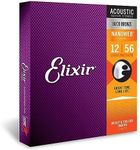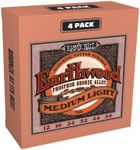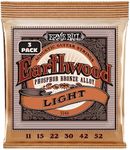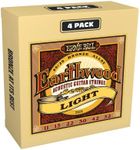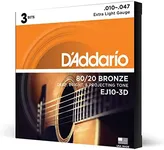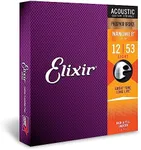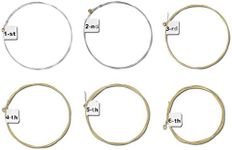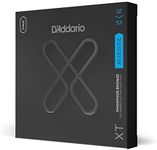Buying Guide for the Best Acoustic Guitars Strings
Choosing the right strings for your acoustic guitar can significantly impact your playing experience and the sound of your instrument. The type of strings you select will depend on your playing style, the genre of music you play, and your personal preferences. Here are some key specifications to consider when selecting acoustic guitar strings, along with explanations to help you make an informed decision.String GaugeString gauge refers to the thickness of the strings, usually measured in thousandths of an inch. This spec is important because it affects the playability and tone of your guitar. Light gauge strings (e.g., .010-.047) are easier to play and bend, making them suitable for beginners or players who prefer a softer touch. Medium gauge strings (e.g., .012-.054) offer a balance between playability and tone, providing a fuller sound while still being relatively easy to play. Heavy gauge strings (e.g., .013-.056) produce a louder, richer tone but require more finger strength to play. Choose a gauge that matches your playing style and comfort level.
MaterialThe material of the strings affects their tone, feel, and longevity. Common materials include bronze, phosphor bronze, and coated strings. Bronze strings (80/20 bronze) have a bright, clear tone and are popular for their crisp sound. Phosphor bronze strings have a warmer, more balanced tone and are known for their durability. Coated strings have a protective layer that extends their lifespan and reduces finger noise, making them ideal for players who want longer-lasting strings. Consider the type of sound you prefer and how often you want to change your strings when choosing the material.
String CoreThe core of the string can be either round or hexagonal. This spec is important because it influences the string's flexibility and tone. Round core strings have a vintage feel and produce a warmer, more mellow tone. They are also more flexible, making them easier to play. Hex core strings are more modern and provide a brighter, more focused tone with better tuning stability. They are also more durable and less prone to breakage. Choose the core type based on your tonal preference and playing style.
Winding TypeThe winding type refers to how the outer wire is wrapped around the core wire. This spec affects the string's feel and tone. There are three main types: roundwound, flatwound, and halfwound. Roundwound strings have a textured surface and produce a bright, articulate tone. They are the most common type and are suitable for a wide range of playing styles. Flatwound strings have a smooth surface and produce a mellow, less bright tone. They are often used in jazz and for players who prefer a smoother feel. Halfwound strings are a compromise between the two, offering a balanced tone and feel. Choose the winding type that best matches your playing style and desired tone.
CoatingCoated strings have a thin layer of polymer that protects them from dirt, sweat, and oils, extending their lifespan. This spec is important for players who want strings that last longer and require less frequent changing. Coated strings can have a slightly different feel and tone compared to uncoated strings, often being smoother to the touch and slightly less bright. If you play frequently or in environments where your strings are exposed to moisture, coated strings can be a good choice. Consider whether you prioritize longevity and ease of maintenance when deciding on coated versus uncoated strings.

